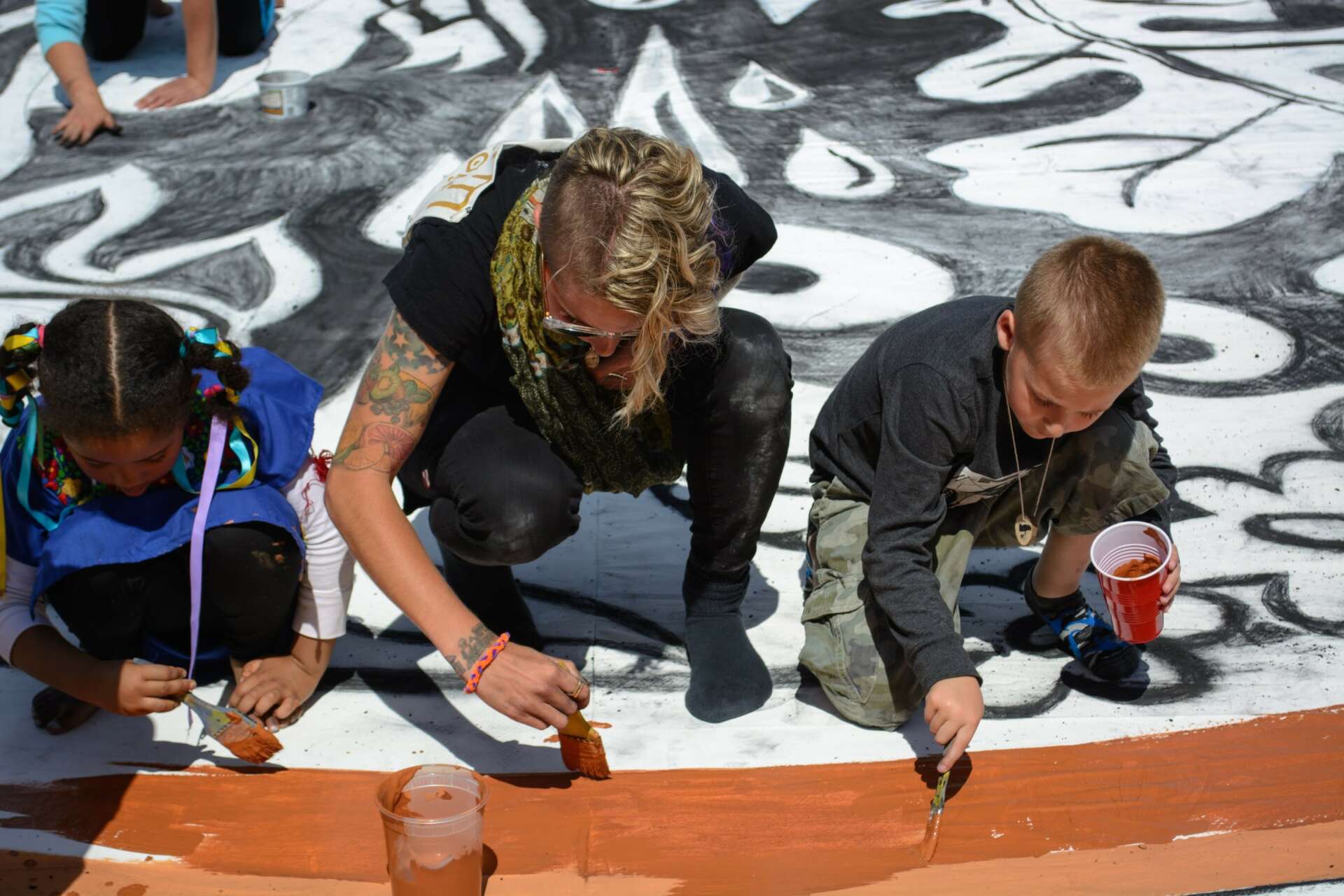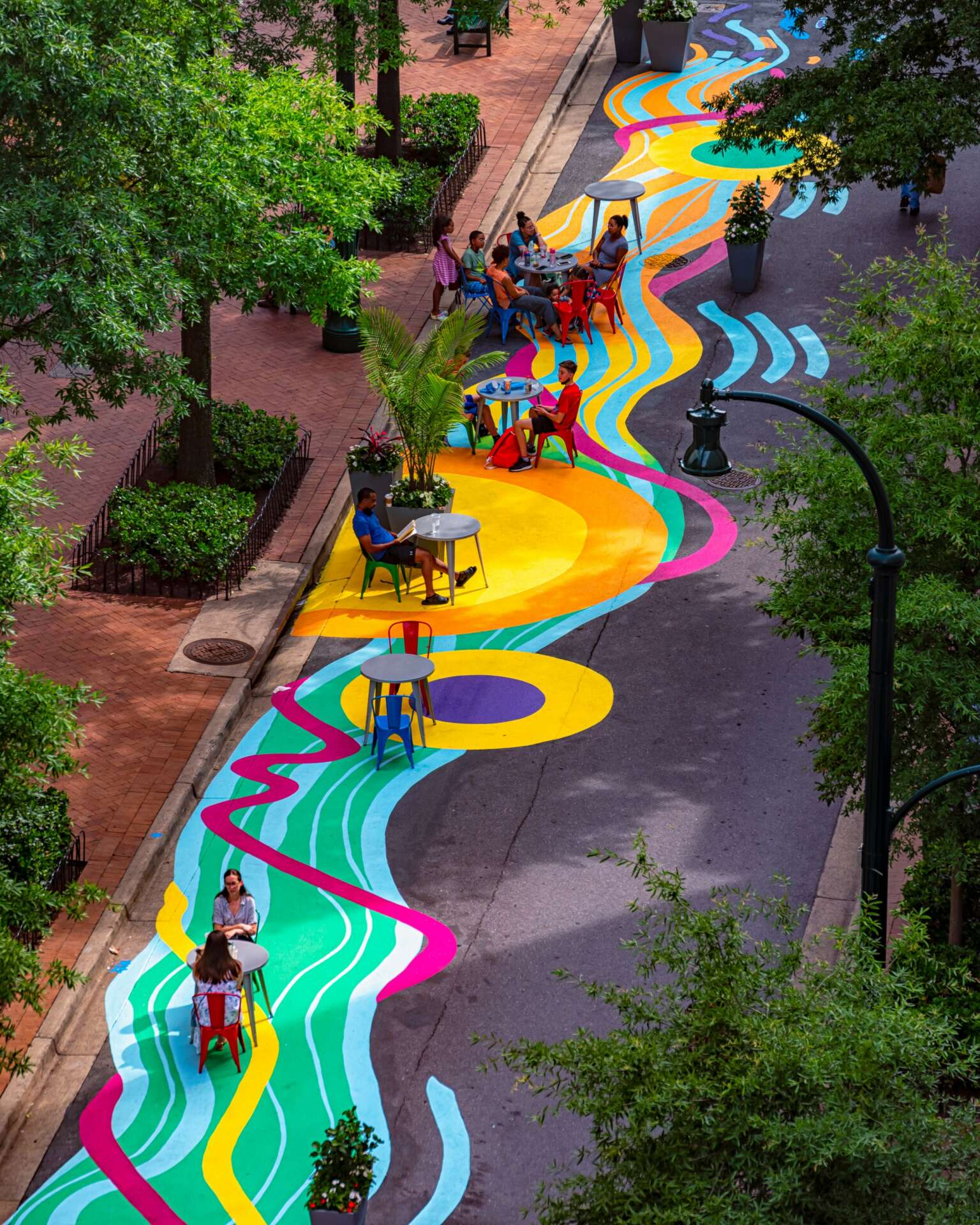We’re excited to introduce you to the always interesting and insightful Chelsea Ritter-Soronen. We hope you’ll enjoy our conversation with Chelsea below.
Chelsea, looking forward to hearing all of your stories today. So let’s jump to your mission – what’s the backstory behind how you developed the mission that drives your brand?
Everything we do at Chalk Riot boils down to advocating for safe, inclusive, healthy public space where communities can freely express themselves and connect with each other.
I began drawing with chalk on the ground because it was legal and accessible, and I was doing a lot of nighttime wheatpasting at the time. A box of sidewalk chalk costs only a few dollars, and rules against sidewalk chalk in public space are rare. After a couple large doodles in 2013 around St. Louis, I quickly realized the power of creating at the foot of cities. It is a wildly acute perspective that becomes meditative, where all my senses shift into a unique hyper awareness. Now that I’ve been chalking for over a decade, I’ve learned there’s often no better way to understand a neighborhood than by crouching on the sidewalk and just observing from that perspective; I notice what kinds of shoes people are wearing, amounts of litter, the age of the sidewalk, languages spoken and with what accents, the ratio of car traffic to pedestrian traffic, and more. Passersby generally don’t pay attention to who or what is at their feet – until there’s art there.
The history of chalk art is surprisingly radical and serves as our namesake. Chalk Riot aims to carry that legacy forward through not only with our actual art, but also with workshops and public speaking. About 75 years before Keith Haring was drawing with sidewalk chalk on New York City subway station walls, women suffragists were organizing chalking parties to advertise local meetings. It was effective because chalk could easily fit in the ladies’ pockets and sleeves, and if washed away by police, the message could be easily reproduced. Centuries ago, muralists hired by the Catholic church in Europe would take to the sidewalks with their pigments to recreate images of the Bible and of the Madonna. These visual stories sometimes became tools of free education in public space for citizens who could not read. Lastly, some of the first ever political cartoons were created in chalk in nineteenth- and eighteenth-century England, which led to some of the first recorded policing of public space and criminalization of artists as such. I really wish we could talk to some of those first chalk artists, but since we can’t, we try to follow in their footsteps and advance the art form. Alice G. Colman was one of those artists, and to maintain her safety and ability to make money busking, she disguised herself as a man.
Being intentional about an all-women crew is rooted in taking up public space boldly with our bodies and self-expression in a country and world that constantly attempts to minimize our presence and contributions. It’s about being brave and supportive in a world where we still experience gender-based street harassment. When we’re creating more industrial applications with street safety murals, it means the world when a mother passing by points out to her child that, “look, girls can do anything, look at that group of girls hard at work!”
People always ask “what if it rains?” as they stop and watch the art’s creation. My response is always “so what if it does?” We maintain too many attachments in this life, and the ephemeral nature of chalk simply reminds us to live in the present. Nothing lasts forever.


Chelsea, love having you share your insights with us. Before we ask you more questions, maybe you can take a moment to introduce yourself to our readers who might have missed our earlier conversations?
Chalk Riot is an all-women mural production house that specializes in artwork on the ground, based in Washington, DC. We believe in chalk for the People, by the People, and recently celebrated our tenth birthday! Our creations range from ephemeral small chalk pastel works on public sidewalks, to large “3D” immersive works for special events, to industrial roadway applications that curb traffic violence and increase pedestrian safety. We’re committed to the pavement as canvas because of the way artwork forces people to literally stop in their tracks and consider the built environment around them in a new light. By bringing attention to surfaces commonly overlooked, we encourage a sense of ownership and connection of these public spaces that serve as the literal foundations of our communities. Clients come to us because they want to foster fun and inviting connections with the public as well as their specific target audiences. Notable companies and organizations with whom we have collaborated include the John F Kennedy Center for the Performing Arts, the DC Department of Transportation, Vevo, the Smithsonian National Gallery of Art, Google, the Special Olympics, Greenpeace International, various universities, Bleacher Report and more.
The ground is the one place we all share besides the water and sky. It’s important that we treat it accordingly. We’ve become hilariously niche technical experts in types of pavement substrates, durability of pigments and art supply brands, traffic safety data, and more!
Since 2013, we’ve created in five countries and over a dozen US states. Just last month, we created a collaborative ground mural in Nairobi, Kenya that served as a conversational tool between hundreds of attendees at a conference about global peacebuilding initiatives. We hope to continue bringing our artwork into these sorts of academic arenas, inviting cross-sector dialogue about how to heal societal divisions and foster healthy public spaces so that our world can thrive.


Can you share one of your favorite marketing or sales stories?
I’ve made three major moves in residence during my Chalk Riot life, and each time the business came with me. I’ve moved from St. Louis, Missouri to Napa, California, to Washington, DC. In between those moves, I’ve done many busking stints in France, Germany, Mexico, Australia, and all over the United States. Every time I moved, people questioned me, challenged me on my decisions. But each time, I followed my instinct, studied the markets, and had dozens of informational coffee meetings with local movers and shakers before ever signing an apartment lease. I never moved to a city without a gig and fresh press release waiting upon my arrival. That being said, I’ve taken too many professional risks to count, but one sales story comes to mind first.
Back in 2015, I was living in Montpellier, France and needed to extend my visa by leaving the EU. I was busking with chalk in Paris and Montpellier, practicing my craft alongside talented graff writers and feeling confident. My dear friend Taryn told me about the Fringe Festival in Perth, Australia, and I put a $1500 flight on my credit card with about $400 in cash to my name. She generously offered her couch and I hit the sunny sidewalks with my chalks almost daily. There was a strong busker network there because of the festival, and I was making enough with my hat out to get by and enjoy life. A couple weeks in, I went to a neighborhood where there’s a large indoor market and lots of modern murals, and pitched the organization that runs the market on a painted pavement mural. I had never painted anything on the ground before, but I needed to pay off my debts! THEY SAID YES! The mural is embarrassing to me these days, I wouldn’t dare share it here, it’s so bad in my opinion, ha! But they offered several thousand dollars, and it was a brilliant learning opportunity. I flew back to France with a fresh visa, international press, sky-high confidence that I could make a real living off of pavement art, and enough cash for a sick couture leather jacket and eventual flight back to the USA. That’s when Chalk Riot really started to become my full-time job.
Since then, we’ve grown Chalk Riot into a multiple six-figure business from a box of 99-cent sidewalk chalk. I’m always investing back into the business, because it consistently comes back tenfold. Money can’t buy happiness, no, but it can buy tools (and plane tickets) to help realize artistic visions, which can make some people pretty happy! Busking on sidewalks taught me that money is just an exchange of energy; people invest in what brings them joy and helps them feel connected to something positive.


Any stories or insights that might help us understand how you’ve built such a strong reputation?
My work experience in other industries is specifically what gave me the skills to own a small business and make it so successfully mobile and marketable. My decade in wine and hospitality taught me sales techniques. My dozen years in theater taught me teamwork, storytelling, deadlines, resourcefulness and a collaborative curiosity. Many years of environmental activism taught me press communications and effective campaign strategies. I always advise young professional artists to prioritize working for others first, because it’s the best way to learn how to work for yourself. I was also trained by union theater designers where apprentice models still reign, and have always had a handful of mentors invested in Chalk Riot’s success.
Honestly, I’m also an amiable person! I’m a natural collaborator and enthusiastic about everything we do because I believe in the cause of bettering public spaces with my whole being. Working outside, it’s a requirement that we enjoy talking to strangers, and by default we become liaisons for whatever cause or campaign for which we’re making art. This is incredibly valuable to our clients, and often we ask them to prep us accordingly on talking points and relevant information.
While I think the paradigm and stereotypes of artists are shifting in this ecommerce age, if creatives can fulfill deadlines, communicate clearly, and center the goals of their clients, they’ll still exceed expectations and easily form lasting professional relationships.
Gratitude shines through everything, and is absolutely infectious.


Contact Info:
- Website: www.chalkriot.com and www.iamchelsea.com
- Instagram: @chalkriot and @iamchelsea_art
- Linkedin: www.linkedin.com/chelsea-ritter-soronen
- Twitter: @chalkriot
- Other: Threads @chalkriot and @iamchelsea_art
Image Credits
Main photo by Lucy Mui Other photos: Nathan Mitchell, Adam Brockett, Israel Valencia


